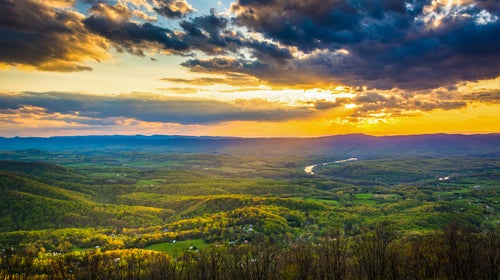The Ultimate Shenandoah National Park Travel Guide
This pastoral stretch of the Southern Appalachian mountains in Virginia is packed with hiking, fishing, road biking, and other adventuresÔÇöif you know where to look
New perk: Easily find new routes and hidden gems, upcoming running events, and more near you. Your weekly Local Running Newsletter has everything you need to lace up! .
It might be easy to overlook this 200,000-acre slice of the southern Appalachians in Virginia. At first glance, Shenandoah National Park doesnÔÇÖt have the obvious cachet of some other units in the park system. But if you know where to look, there is an abundance of adventure within its green ridges and pastoral valleys. The mountains that lie within the park boundaries rise dramatically from the valley floor, some gaining 3,000 feet of elevation. From a distance, they may appear deceptively mellow, but theyÔÇÖre filled with craggy granite peaks, waterfalls, and tight gorges, so hikes are often full of rock scrambles and river crossings.
Given its proximity to major cities like Washington, D.C., and Baltimore, 90 minutes╠řto two hours east, Shenandoah sees its fair share of crowds during the high seasons╠řof summer and fall. Thanks to the convenience of the Skyline Drive, a 105-mile road that bisects the park from north to south, most of these visitors treat Shenandoah as a drive-through park, ogling from roadside overlooks and stretching their legs on short nature walks. But with roughly 40 percent of its land protected as wilderness, 100 miles of the Appalachian Trail, and world-class trout streams, youÔÇÖd be missing out if you didnÔÇÖt go beyond the main stretch.
Most important of all, Shenandoah is one of the most user-friendly parks. Skyline DriveÔÇÖs milepost system makes finding trailheads a cinch, while a pair of lodges in the middle of the park,╠ř and , serve as ideal base camps. ItÔÇÖs also one of the few dog-friendly national parks, with the majority of trails open to pets on leashes. And unlike many units, including the nearby Great Smoky Mountains, which doesnÔÇÖt allow climbing and has limited cycling opportunities, Shenandoah is a multisport heaven, with rock climbing, fly-fishing, and road biking built into the management plan.
What You Need to Know Before Visiting Shenandoah
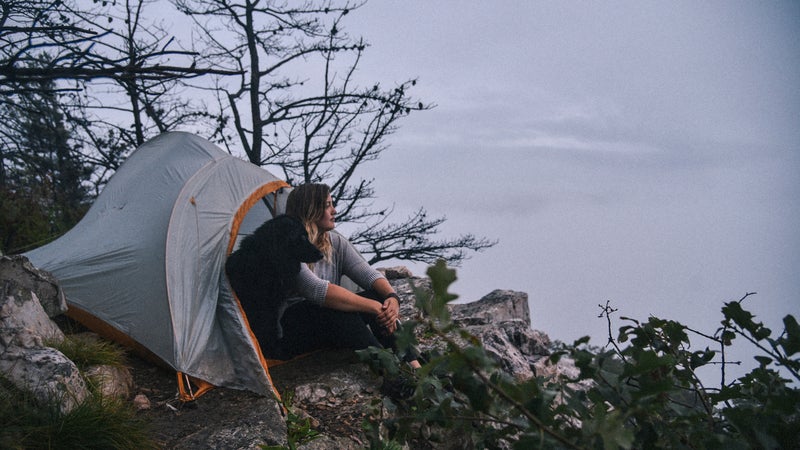
Prepare to see a lot of the park in just a few days. At just 200,000 acres with a single road delivering you directly to trailheads and campgrounds, itÔÇÖs easy to see the highlights in little time. Set up at one of the lodges or campgrounds in the middle of Skyline Drive, and you can branch out to all corners of the park without much drive time. This also means you might experience a bit of traffic along Skyline Drive, especially during summer and fall weekends.
Expect to work for the best hikes. Unlike some parks, where easy nature trails will deliver you to iconic landscapes, ShenandoahÔÇÖs most popular hike is also one of its toughest. The nine-mile loop to 3,200-foot Old Rag promises a prominent rocky summit with banger views. But itÔÇÖs also one of the parkÔÇÖs most isolated peaks, requiring a four-mile approach complete with a rock scramble to get to the top. Arrive at the parking lot before 7 a.m. to avoid the heaviest crowds (the trail sees roughly 100,000 hikers every year), and be on your A-gameÔÇöOld Rag is a , with several people airlifted or carried off the peak every year.╠ř DonÔÇÖt be a statistic.
Bring a fly rod. Shenandoah has some of the best backcountry angling on the East Coast, with a thriving native fishery that supports the crown jewel of southern Appalachian streams:╠řthe native brook trout. The rivers are tight, boulder-choked, and packed with waterfalls and cascades, so be prepared to work for each strike.
How to Get There╠ř
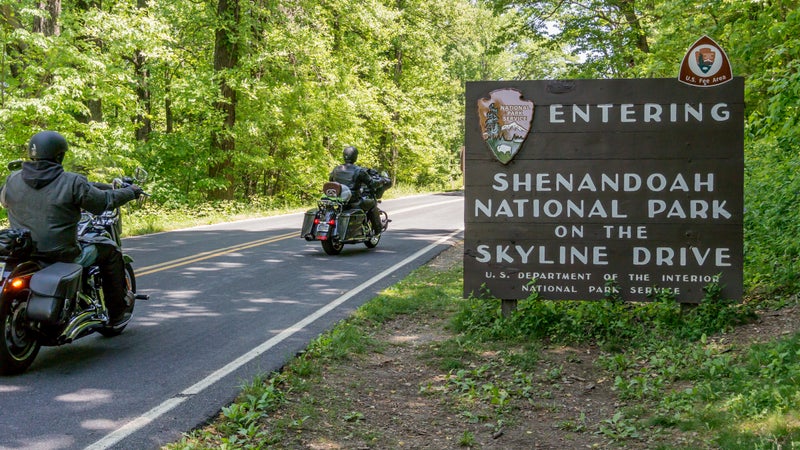
Most visitors who arenÔÇÖt in driving vicinity typically fly into Washington, D.C., where two major airports (Reagan and nearby Dulles) serve as a hub for incoming traffic outside of the mid-Atlantic region. From D.C., itÔÇÖs a straight shot west on Interstate 66 for 62 miles until you reach the northern entrance in Front Royal, making Shenandoah one of the more accessible national parks from a major U.S. city. Single vehicle entrance fees are $30 a day. ThereÔÇÖs no public shuttle system inside the park, but Skyland Lodge╠řoffers the occasional wine and whiskey shuttle from its╠řlodge into the surrounding communities, where a number of wineries, breweries, and distilleries have popped up in recent years.
WhatÔÇÖs the Best Time of Year to Visit?╠ř
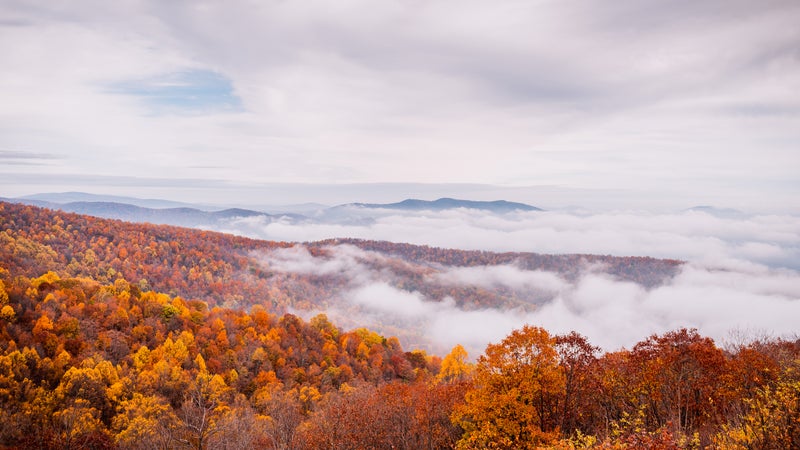
Summer╠ř
The South and mid-Atlantic can be sweltering in the summer, but Shenandoah stays relatively cool, with temperatures in the mountains roughly ten degrees lower than the valley below. You can expect highs hovering in the low╠řto mid-80s, and countless waterfalls and swimming holes scattered throughout the park help you beat the heat in July and August. The hardwood canopy is at its most lush, and while spring might be peak wildflower season, June has its own floral display as mountain laurel blooms white. But expect crowds. If youÔÇÖre planning to backpack on the Appalachian Trail╠řand stay in shelters, consider a late-July or August trip, when the majority of thru-hikers are farther north.
Fall╠ř
If Shenandoah is famous for one thing, itÔÇÖs fall foliage. The park has a thick and lush hardwood canopy that goes full Technicolor in October, attracting thousands of leaf peepers looking for Instagram gold. Given the short drive from D.C. and Baltimore, Shenandoah is especially busy on weekends, so expect traffic on Skyline Drive and fully packed campgrounds and lodges. ThatÔÇÖs not to say you should avoid the park during the fall. The natural show of color is spectacular, and the temperatures are mild (highs in the mid-60s, lows in the 40s), but skip a crowded driving tour and get into the backcountry. Check out the , a nine-mile loop past waterfalls and rocky outcroppings that gets you deep into that vibrant canopy. And check the parkÔÇÖs before you go, so you know when peak foliage hits.
Winter╠ř
These months are relatively mild, with temperatures ranging from the low 20s to high 30s in January and February. The park will see the occasional snowstorm, particularly at higher elevations, and youÔÇÖll even find Nordic skiers doing laps at Big Meadows after deep storms. Keep in mind that portions of Skyline Drive are closed during bad weather, and all of the parkÔÇÖs lodging and campgrounds are shuttered between November and March. Services are limited, but you could argue that winter is the best time to visit Shenandoah if you like solitude. The lack of tree cover reveals long-range views that are hidden during summer, waterfalls can be frozen, and you have a better chance of seeing wildlife, like foxes and bobcats, which are more active during the colder months. Meanwhile, the Appalachian Trail, which can be a zoo in the summer, is empty between November and March.
Spring╠ř
The park is surprisingly sleepy during spring. The campgrounds open at the end of March, but April can still be chilly and even snowy in the higher elevations, which keeps the crowds at bay. The park has 850 different species of wildflowers that put on a spring show rivaling╠řthe more popularÔÇöand crowdedÔÇöfall foliage season. The wildflowers start popping in late March, but things really get going in April, when trillium and pink ladyÔÇÖs slippers bloom. When May rolls around, the park is covered in pink azaleas. Check out the Park ServiceÔÇÖs , which lists when popular species are blooming, but keep in mind that Skyland and Big Meadows Lodges donÔÇÖt start accepting guests until May.
Where to Stay in Shenandoah National Park╠ř
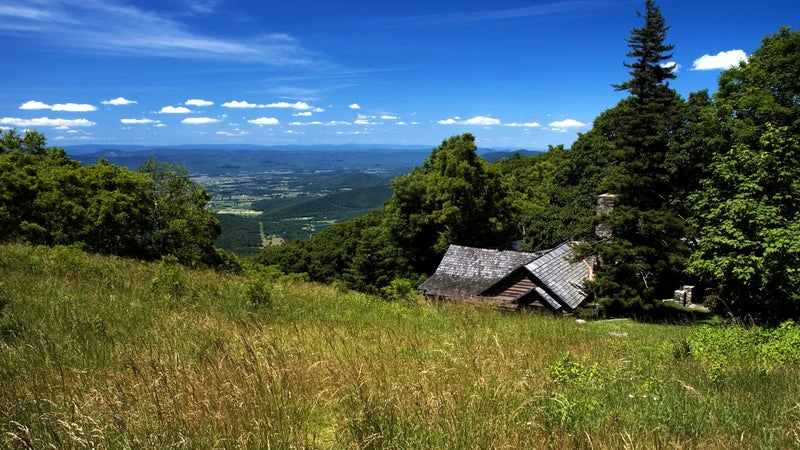
ShenandoahÔÇÖs two lodges are both located roughly in the middle of Skyline Drive, in the center of all the action. ╠ř(from $115), a stone-and-chestnut lodge built in the late 1930s, is the signature property. ItÔÇÖs is a mix of 29 traditional hotel rooms and 72 rustic cabins and multiroom units, all of which surround a main lodge building with a dining room and a taproom. The rooms are clean, and the local beers on tap are a nice touch, but you stay here mostly for the location; Big Meadows sits at milepost 51, a mile from the big meadow itself, which is the prime stargazing╠řlocation in the parkÔÇörangers lead occasional here.
╠ř(from $103), at milepost 41.7, is a former mountain retreat from the late 1800s thatÔÇÖs been transformed into a series of cabins and lodges scattered over 27 acres. While more upscale than Big Meadows thanks to a recent renovation, Skyland╠řalso offers small one-bedroom cabins that are more rustic. YouÔÇÖll also find family-friendly events like live bluegrass and clogging at the Pollock Dining Room, plus the Mountain Taproom. Both lodges close in November and typically reopen at the end of May.
The park also has four frontcountry campgrounds located along Skyline Drive that are a mix of first-come, first-serve and reservable sites. The 200-site ($15), the biggest in the park, is located at mile 79.5,╠řat the southern end of Skyline Drive, on top of Big Flat Mountain with big views into Shenandoah Valley. ItÔÇÖs a good base camp if you want to explore Big Run Wilderness╠řand has a few tent-only sections that sit just off╠řthe Appalachian Trail. ($15), at milepost 57.5,╠řhas 31 first-come, first-serve sites and 15 primitive cabins that provide good access to the Appalachian Trail and Dark Hollow Falls.
Finally, the operates a series of cabins along the Appalachian Trail through the mid-Atlantic, six of which are located inside Shenandoah. All the cabins inside the park are primitive structures with wood stoves that were built by the Civilian Conservation Corps or local moonshiners. TheyÔÇÖre all hike-to-only and offer a one-of-a-kind backcountry experience. Be sure to make your reservations early (60 days in advance) via the clubÔÇÖs website.
What to Do While YouÔÇÖre There╠ř
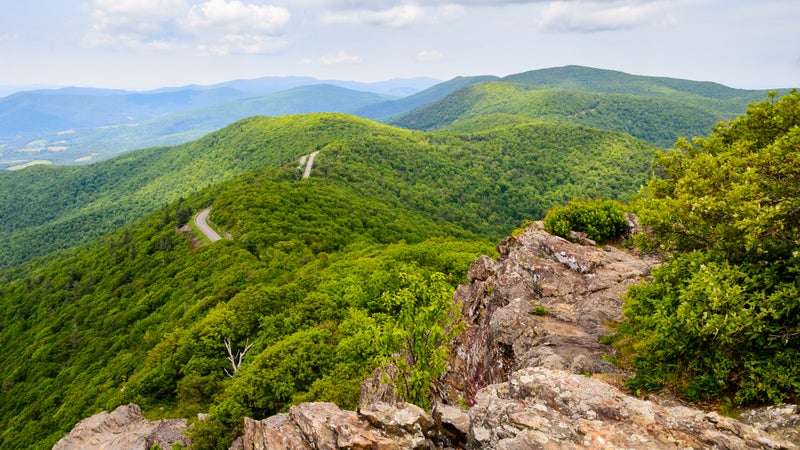
Hiking╠ř
There are a few different ways to reach the top of Hawksbill Mountain, the tallest mountain inside the park, at 4,050 feet, but the easiest is via the , a two-mile round-trip that starts at milepost 46.7 on Skyline Drive and avoids most of the elevation gain that Lower Hawksbill Trail requires. The short trail also packs a punch, passing through a high-alpine Frasier fir and red spruce forest thatÔÇÖs more common in northern climates╠řand climbing rocky outcroppings before hitting the summit proper, where an observation platform and long-range views of the park await.
The Cedar Run and Circuit is a 7.3-mile loop that has 2,794 feet of climbing and passes five waterfalls. Start at the Whiteoak Canyon Trailhead, at milepost 42.6, taking the trail of the same name across a series of steel footbridges before climbing switchbacks to an overlook of the 85-foot╠řWhiteoak Canyon Falls. After 2.5 miles, use the WOC Fire Road to connect to Cedar Run Trail, where youÔÇÖll hit a natural waterslide with╠řsmooth rock sloping╠řinto a pool, called ÔÇťThe Slide,ÔÇŁ and another falls that forms a pool inside a narrow rock gorge. Tackle this loop in summer and youÔÇÖll have countless opportunities to swim in╠řmountain streams.
Backpackers looking for a bucket-list trek can hike the entire 120 miles of the Appalachian Trail through the park (plan for seven╠řto ten╠řdays)╠řor spend a few days hiking a 33-mile section that runs through the northern section. Start at Jenkins Gap, at mile marker 12.3, and head south on the Appalachian Trail for a romp along the parkÔÇÖs ridgetops. The trail culminates with Marys Rock, a 3,514-foot mountain with large╠řgranite fins jutting out from the peak that offers long-range views of Shenandoah Valley.
Biking
Skyline Drive was the product of the Civilian Conservation Corps, built originally with cars in mind╠řbut makes for a great cycling route. The 105-mile, two-lane blacktop follows the ridgeline through the center of the park, offering 75╠řscenic overlooks and a whopping 15,000 feet of climbing. ItÔÇÖs brutalÔÇöeither all up or all down, with nary a flat stretch between, but the parkÔÇÖs two lodges situated in the center of the action make this an ideal two-day operation. And remember, for every miles-long climb, youÔÇÖll enjoy an equally long downhill, and there are plenty of opportunities for short side hikes. In other words, consider this a scenic cruise, not a Strava KOM.
Rock Climbing╠ř
Shenandoah is probably best known for its hiking and waterfalls, but thereÔÇÖs so much granite inside the park that it has become a hot spot for climbing, too. The 3,284-foot peak of Old Rag, in the southern portion of the park, has several sections of exposed granite that has╠řmade it one of VirginiaÔÇÖs classic climbing destinations. It offers everything from trailside bouldering to two-pitch trad lines. On the west-facing side of the peak, the Summit Area Crags have╠řa long approach (at least five╠řmiles, depending on your route), the longest routes, and the most breathtaking views,╠řbut the area is also cooler in summer because of the elevation. Ascending the left side of the cliff, Pure Fun is a beautiful, 5.7 single-pitch trad route to the top of the mountain. It follows a crack into a small roof before topping out with summit views. offers guided trips if you want to go with pros in the know. Just east of Old RagÔÇÖs Summit, the Skyline Wall has grippy routes in a variety of ranges with amazing views. You can even find beginner options in the 5.5 range, like Keyhole Left, a 65-foot corner-and-crack combo thatÔÇÖs way more fun than the grade suggests.
Fly-Fishing╠ř
More than 70 mountain streams drop off the ridgeline that makes╠řup Shenandoah National Park, and many of those rivers host healthy populations of native brook trout, as well as rainbow and brown trout. In other words, itÔÇÖs a backcountry anglerÔÇÖs dream, especially if you like tight headwaters fishing. Head to Rapidan River, a waterway so storied it has a fly named after it: the Mr. Rapidan. YouÔÇÖll find it in the central section of the park, where Mill Prong and Laurel Prong meet to form the larger Rapidan, a catch-and-release stream with brookies up to ten╠řinches. Bonus: youÔÇÖll get to see President HooverÔÇÖs .
The Best Places to Eat and Drink Around the Park╠ř

The parkÔÇÖs proximity to Washington, D.C., means some of the big city spills over into the hills and meadows surrounding the park. The northern entrance of Front Royal╠řis a gateway town with all the quaint historic charm youÔÇÖd expect from a small village settled in colonial times, as well as one of the best cheeseburgers in the state at . If you want a more farm-to-table experience, head to the small town of Staunton, west of the park. is the mountain town refuge of Ian Boden, a former Manhattan-based╠řchef and two-time James Beard nominee╠řwho creates inventive but hearty meals that rely on the farms scattered through the Shenandoah Valley. Order the pork sausage and clam stew.
For some of the best beer and food in Virginia, head 25 miles south from the parkÔÇÖs Rockfish Gap entrance to Charlottesville, home to the University of Virginia, Thomas JeffersonÔÇÖs house, and one of the most vibrant craft beer scenes in the Old Dominion. was one of the stateÔÇÖs╠řfirst craft breweries and still makes an excellent IPA. After saving some calories with a salad at , head to for its Peanut Butter and Friends cookie, which includes╠řsalty pretzels and chocolate chips.
If You Have Time for a Detour╠ř
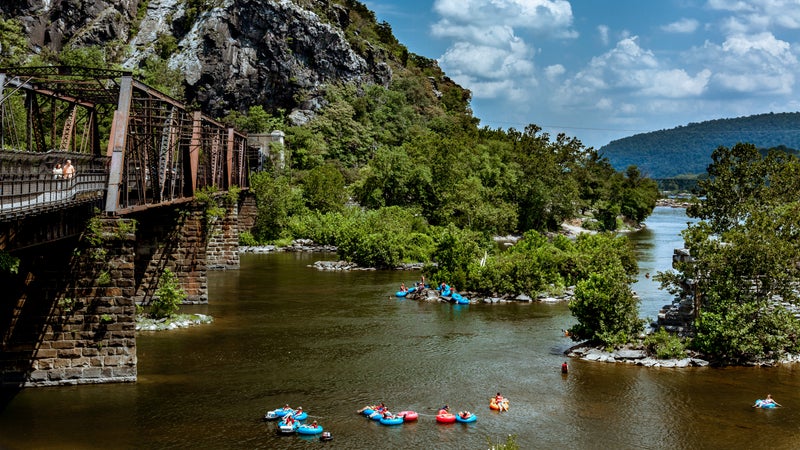
There are many country songs written about the Shenandoah River, and for good╠řreason. The languid waterway, which divides and gives life to the pastoral Shenandoah Valley just west of the park, is a source of both╠řbeauty and life for the farming communities built on its banks. The South Fork has the best paddling, with more than 30 miles of easygoing Class I action and╠řthe occasional Class II thrown in to keep things interesting. There are popular tubing sections and afternoon paddles, and a bevy of public land and commercial campgrounds located throughout make this river the ideal multiday romp. Check out the 28-mile stretch from the town of Luray╠řto Jefferson National Forest. , in the nearby town of Bentonville, has rentals and shuttles.
The 469-mile Blue Ridge Parkway begins where Skyline Drive ends, meaning╠řif you have a week to spare, you have an epic Southern road trip that carries you all the way down to Great Smoky Mountains National Park. If not, just stick to the northern 100 miles of the parkway, dubbed the ÔÇťRidgeÔÇŁ section, which is bookended by , a towering rock outcropping with great views at the beginning of the Parkway, and Peaks of Otter, a crest that once marked the northern boundary of the Cherokee Nation. The section is full of scenic overlooks and quick day hikes.
How to Be a Conscious Visitor╠ř
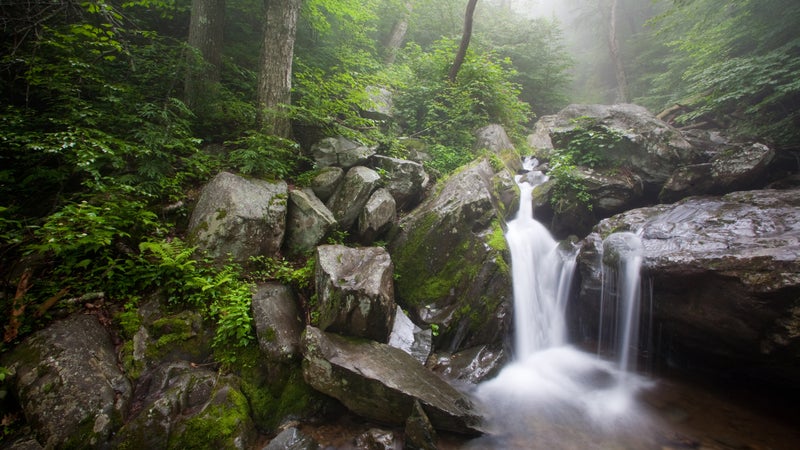
The park sees heavy foot traffic, so the proliferation of social trails is a problem, particularly around rock outcroppings, some of which have been closed to camping, hiking, and climbing. Do your part by sticking to the main path. The park has had issues with an invasive beetle that feeds on ash trees that are often transported via firewood from outside, so buy your wood inside the parkÔÇöitÔÇÖs USDA-certified to be beetle-free. If you plan to fish, check regulations before you set out, and know how to handle the fish you catch. All of the parkÔÇÖs streams are open to catch-and-release fishing, and a handful allow you to keep what you catch, but the park has a healthy wild brook trout population that needs to be handled with care.

